Story Telling
Disruptive Experience
In one of my previous part-time jobs, the company I worked with had to increase production output due to higher customer demand. The heightened demand resulted from a change in the product package, a strategy that the company had developed to boost its sales. I was in charge of a workgroup tasked with determining how the increased production would be made possible without increasing the number of employees. Due to the need, I assembled the team that I was assigned to work with, and we both brainstormed for possible solutions. The only solution availed by most of the group members was to increase the number of staff, but the company made it clear that they had no intention of hiring staff and that they would eventually have to let go. Following a lengthy discussion, one of the team members came up with the idea of increasing the work time by providing extra shifts. Dinner could be provided so that the employees could proceed with their shifts with limited disruption. The free meal and the overtime were the best intervention in increasing employee morale and assisting in meeting the demand for increased production.
Describe the tension between ignoring, insulating, and avoiding this new information, and how it gave way to opening, embracing, and integrating this disturbance.
The principal challenge that was eminent in the decision was the conflict between the adoption of the democratic and the top-down control method of decision-making. The team I was assigned to incorporated employees from a higher rank; therefore, there was a feeling of empowerment in decision-making. The competition in coming up with a solution created what Todnem (2005) describes as palpable energy. Most of the group members seemed to work harder in coming up with the solution; they availed more ideas and portrayed a heightened involvement in the process. Such competition allowed us to come up with the best solution.
What was the role of self referencing, remembering who you are, your values, aspirations, and gifts, to the eventual innovation or growth?
Through self-referencing, I realized I could not resolve the issue alone. I had to acknowledge that teamwork and collaboration are among the leading interventions in problem resolution. By self-reflection, I could determine what was possible and the ideas that were not practicable. I had to listen and explore, learn and adjust, focus and align, and also link and leverage the different ideas availed in during the brainstorming session. The self-reflection was essential in coming up with the best intervention. It allows them to be clear on their core values which helps them in better decision-making.
Why is this an important capability for leaders and why are you a better leader as a result of this experience?
The principal advantage of self-reflection to leaders is that it aligns a leader’s objectives and goals with that of an organization. It allows a leader to determine the compatibility between their actions and the possibility of such actions meeting the organizational mission and vision (Nesbit, 2012). Self-reflection also strengthens emotional intelligence in leaders and prevents them from making decisions based on emotions. Additionally, self-reflection enhances confidence which is essential for leaders to build influence, make a decision, and communicate effectively (Ayduk & Kross, 2010). The other benefit of self-reflection to leaders is that it helps them to act with integrity. They make decisions based on clearly defined values, even in stressful conditions.
References
Ayduk, Ö., & Kross, E. (2010). From a distance: implications of spontaneous self-distancing for adaptive self-reflection. Journal of personality and social psychology, 98(5), 809.
Nesbit, P. L. (2012). The role of self-reflection, emotional management of feedback, and self-regulation processes in self-directed leadership development. Human Resource Development Review, 11(2), 203-226.
Todnem By, R. (2005). Organisational change management: A critical review. Journal of change management, 5(4), 369-380.
ORDER A PLAGIARISM-FREE PAPER HERE
We’ll write everything from scratch
Question
Unit 8 Discussion 1 – Story Telling
Tell a story about a time in your life where you encountered disruptive information that resulted in innovation or growth.

Story Telling
Describe the tension between ignoring, insulating, and avoiding this new information, and how it gave way to opening, embracing, and integrating this disturbance. What was the role of self referencing, remembering who you are, your values, aspirations, and gifts, to the eventual innovation or growth? Why is this an important capability for leaders and why are you a better leader as a result of this experience?
Read at least one classmate’s story, maybe someone’s work you have not read before. Reflect on something in his or her story that you find surprising and that you recognize within yourself.


